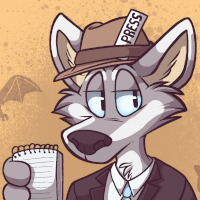Scurry: The Doomed Colony, by Mac Smith – Book Review by Fred Patten
by Pup Matthias
Submitted by Fred Patten, Furry’s favorite historian and reviewer.
 Scurry: [Book 1] The Doomed Colony, by Mac Smith. Illustrated.
Scurry: [Book 1] The Doomed Colony, by Mac Smith. Illustrated.
Vancouver, WA, Easy Prey Entertainment, November 2017, hardcover $30.00 (unpaged [104 pages]), softcover $20.00, Kindle $11.99.
This is the first collection of one of the best, largest (13.7” x 8.3”), and most beautiful anthropomorphic-animal comic strips on the Internet. Mac Smith, a graphic designer in Portland, Oregon, began Scurry: A Post-Apocalyptic Mouse Tale on January 17, 2016, and has been posting about two pages a week. The Doomed Colony contains Part I, Lingering Light, Part II, Beasts of Winter, and Part III, Grim Shadows. These add up to 84 pages, and an Afterword, an extensive Cast of Characters, and samples of Smith’s working process bring The Doomed Colony up to 104 pages.
Smith ran a Kickstarter campaign to raise $8,000 to publish this book. He got $101,230 from 2,129 backers in a month. Smith says in his Afterword that he has not read any of the anthro-animal books that readers have been recommending to him. His influences are 1980s movies like The Secret of NIMH, The Dark Crystal, and The Neverending Story.
Scurry is set in a “post-apocalyptic” world in which the humans are dead or gone but their cities are undamaged. There has been no explanation yet of what happened to the humans (despite the book’s cover, no bodies or skeletons are around), or whether what happened is responsible for the animals’ intelligence (although probably this is just a talking-animal fantasy). The mice in the colony wonder whether the humans could return, or whether there are still some left elsewhere. The setting could be Smith’s Pacific Northwest; the fauna and flora fit it. The rusted and decayed look of the buildings and vehicles, and the overgrown lawns implies that humanity disappeared about a year earlier. Food in the houses has run out. Pets like cats have turned feral and hunt the mice for food.
The Doomed Colony is that of the mice in a house in an unnamed suburban neighborhood. They have eaten all of the food that they can find in their own and other nearby homes. The local ex-pet cats are growing increasingly dangerous. Feral wildlife is moving in; some like beavers and moose are harmless, but others like hawks, wolves, snakes, and owls eat mice. The colony is divided between those who want to stay put and explore farther for food, and those who want to move the whole colony into a nearby city where there may be more food and shelter from wild animals.
Politics makes the debate more convoluted. The mice have been ruled well by an Elder Council, but the Council is literally dying of old age. Is the Council’s preference to stay put based on wisdom, or a refusal to consider new ideas? Is Council Leader Orim’s wish to be replaced by his daughter Pict, whom he has trained to replace him when he dies, a good one, or is it pure nepotism? Is Resher, who leads the faction to move into the city, really working for the colony’s benefit, or does he plan that the colony’s upheaval will give him the chance to take over its leadership?


 Marking Territory, by Daniel Potter. Illustrated by Johanna T.
Marking Territory, by Daniel Potter. Illustrated by Johanna T. Mist, by Amy Fontaine
Mist, by Amy Fontaine
 The Book of Dust. Volume 1, La Belle Sauvage, by Philip Pullman. Illustrated by Chris Wormell.
The Book of Dust. Volume 1, La Belle Sauvage, by Philip Pullman. Illustrated by Chris Wormell. Mark of the Tiger’s Stripe, by Joshua Yoder. Maps by the author.
Mark of the Tiger’s Stripe, by Joshua Yoder. Maps by the author.



 Otters in Space III: Octopus Ascending, by Mary E. Lowd
Otters in Space III: Octopus Ascending, by Mary E. Lowd